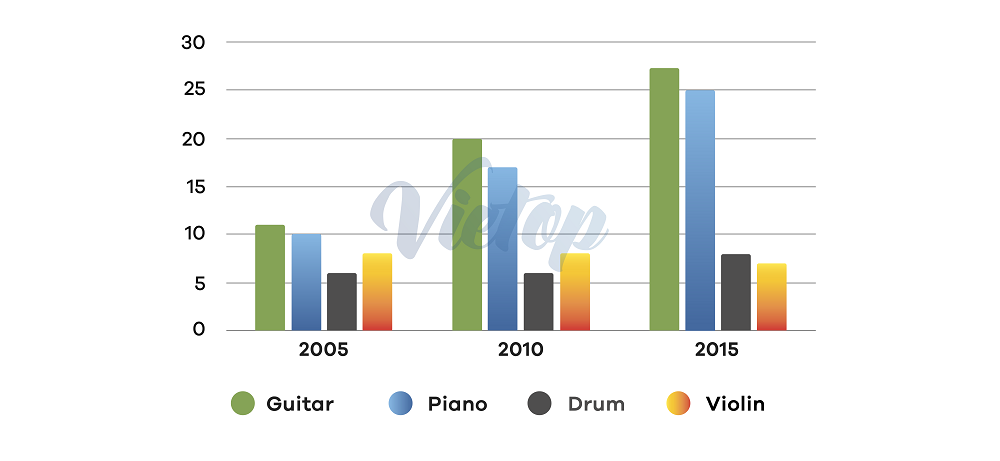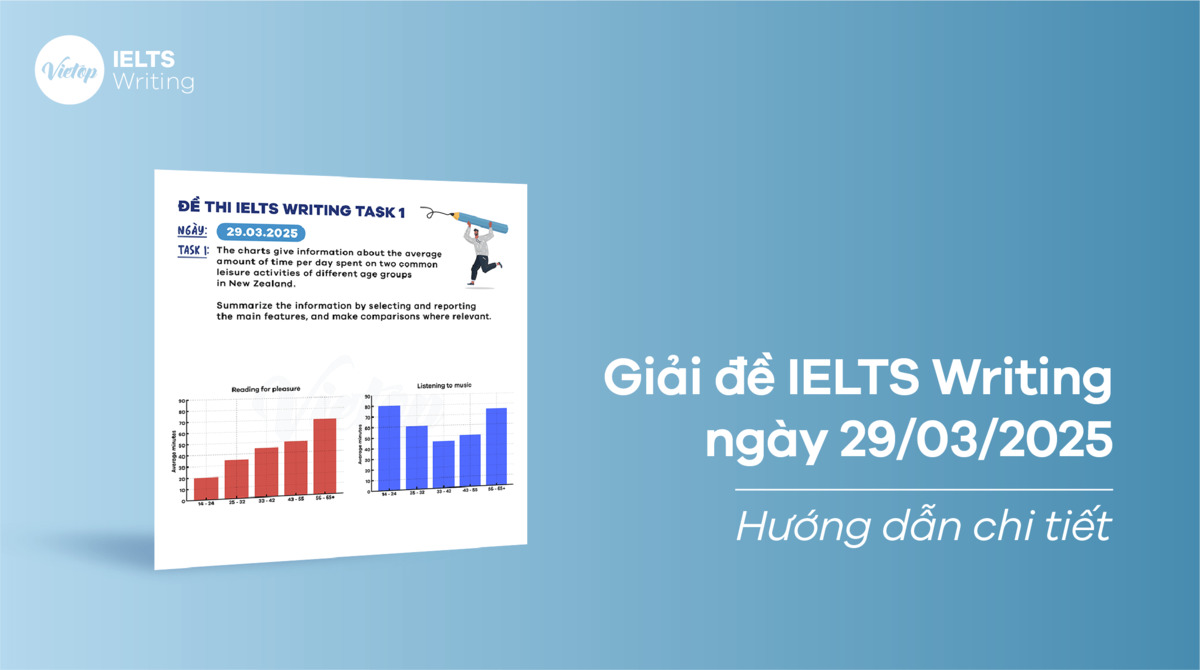Vietop English gửi đến bạn bài giải đề IELTS Writing ngày 26/02/2022, các sĩ tử nhớ lưu lại để ôn tập IELTS Writing nhé!
IELTS Writing Task 1
| Task 1: The bar chart showed the percentage of school children learning to play four different musical instruments (violin, guitar, piano, drums) in 2005, 2010, 2015. |

Xem thêm: Khóa học IELTS online và luyện thi IELTS được nhiều bạn tại TPHCM theo học nhất – Cùng tìm hiểu ngay nhé
Sample
The bar graph compares the percentages of students who learned to play four distinct types of musical instruments in three separate years: 2005, 2010, and 2015.
Overall, with the exception of the violin, the study’s instruments were learned by considerably more pupils in 2015 than in prior years. Furthermore, the guitar and piano were the most popular instruments to learn throughout all of the years studied.
In 2005, roughly 11% of schoolchildren were learning to play the guitar, piano, or violin, compared to only 5% of kids learning to play the drums. By 2010, the guitar and piano had nearly doubled in popularity, with over 20% and 18% of pupils learning to play them, respectively. In the same year, the percentage of students learning to play the drums remained unchanged, while the percentage of students learning to play the violin declined marginally.
In 2015, the number of schoolchildren studying the guitar increased by around 10%, while the percentage of students learning the piano more than doubled to almost 40%. Furthermore, although the number of children studying the drums climbed slightly to 8%, the percentage of children learning the violin decreased fairly to only 5%.
Xem thêm:
Cách làm dạng bài Table – IELTS Writing Task 1 chi tiết nhất
Cách viết IELTS Writing Task 1 từ A – Z cho người mới bắt đầu
Phân tích
Số lượng học sinh học các nhạc cụ nhìn chung là tăng, ngoại trừ đàn violin.
Đoạn body 1 so sánh các loại nhạc cụ năm 2005 (guitar, piano, violin cao hơn trống); Đồng thời thể hiện sự tăng trưởng về phần trăm của các nhạc cụ này từ 2005 đến 2010. → Lưu ý luôn so sánh về cả chiều dọc (số liệu trong cùng một năm) và chiều ngang (số liệu giữa các năm với nhau) để bố cục bài chặt chẽ.
Đoạn body 2 tập trung mô tả số liệu năm 2015, thể hiện sự đối lập giữa guitar, piano, drum (tăng) và violin (giảm).
Xem thêm: Giải đề IELTS Writing ngày 17/02/2022
IELTS Writing Task 2
| Task 2: Some people think that too much attention and too many resources are given to the protection of wild animals and birds. Do you agree or disagree? |
Sample
Undoubtedly, wild creatures are at risk of extinction today, and authorities are working to put in place critical safeguards to protect them. However, I believe that humans devote far too much time and resources to saving wildlife. There are several important reasons supporting this viewpoint which would be discussed objectively during the course of this essay.
To begin with, wild animals do not appear to have the same impact on humans as other animals. Plants that create oxygen, absorb carbon dioxide, and maintain the earth’s climate are a good example. People may not have enough oxygen to breathe when they’re on the verge of extinction. As a result, human survival could be jeopardized. In contrast, when dinosaurs vanished in the past, humans continued to develop at a rapid pace, as they do today. People, in my interpretation, usually protect animals out of ethical concerns. As a result, humans should not go overboard in any effort to save them.
Furthermore, authorities should devote significant resources to the solution of other, more pressing issues. For example, today’s globe still has a large number of disadvantaged individuals who are unable to achieve their fundamental necessities, such as food, healthcare, or education, or who are suffering from life-threatening diseases, such as HIV and cancer, which are still untreated. As a result, governments must maintain a strong appeal for assisting individuals rather than helping other species.
Finally, authorities can come up with some simple solutions for protecting wild animals. For instance, government leaders can build awareness of saving wildlife and impose some heavy punishments for poachers who damage wild animals. In this way, governments can save a large amount of money from this solution.
Finally, I strongly believe that wild animals and birds must be protected. Authorities, on the other hand, cannot afford to be extravagant in order to save them.
Có thể bạn quan tâm:
Cách luyện IELTS Writing Task 2 ăn trọn điểm trong vòng 1 tháng
Cách làm dạng bài IELTS Writing Task 2 – Agree or Disagree chi tiết
Vocabulary:
- Safeguard (n): biện pháp bảo hộ
- Be on the verge of extinction: bên bờ vực tuyệt chủng
- Be jeopardized (adj): bị ảnh hưởng nghiêm trọng
- Ethical concern (n): vấn đề về đạo đức
- Poacher (n): người săn trộm
- Extravagant (adj): phung phí quá mức
Phân tích
Bài viết nghiêng về quan điểm con người đang tập trung quá nhiều vào việc bảo vệ động vật hoang dã.
Đoạn body đầu tiên giải thích việc động vật hoang dã không ảnh hưởng trực tiếp đến đời sống con người, mà thay vào đó thực vật mới tác động đến sự sống con người qua việc cung cấp oxy. Động vật hoang dã mặc dù có thể ở trên đà tuyệt chủng nhưng con người vẫn có thể phát triển nếu không có sự tồn tại của chúng (ví dụ về khủng long). Việc bảo vệ này thường dựa trên các giá trị về đạo đức hơn là giá trị thực tiễn.
Xem thêm:
Trọn bộ đề IELTS Writing Task 1 và IELTS Writing Task 2 qua từng năm
Tương tự, đoạn body 2 nêu lên quan điểm về các cơ quan chức năng nên dành nguồn lực để giải quyết các vấn đề khác cấp bách hơn: cung cấp nhu cầu thiết yếu của con người (lương thực, chỗ ở, giáo dục, y tế,…) để đảm bảo sự phát triển của xã hội. Đoạn body 3 gợi ý một vài cách thức đơn giản để bảo vệ động vật hoang dã; Ví dụ: phạt nặng những người săn trộm động vật trái phép.
Trên đây là bài mẫu IELTS Writing ngày 26/02/2022, hy vọng chia sẻ trên sẽ giúp ích được bạn trong quá trình luyện IELTS. Chúc bạn học tốt và đạt được điểm số cao trong kì thi sắp tới! Và đừng quên cập nhật liên tục đề thi IELTS writing 2022 của Vietop để chuẩn bị thật tốt cho kỳ thi sắp tới nhé!
Xem thêm:


![[ACE THE TEST] Giải đề IELTS Writing ngày 07/04/2025](https://vietop.edu.vn/wp-content/uploads/2025/04/giai-de-ielts-writing-ngay-07-04-2025.png)

![[ACE THE TEST] Giải đề IELTS Writing ngày 15/03/2025](https://vietop.edu.vn/wp-content/uploads/2025/03/giai-de-ielts-writing-ngay-15-03-2025.jpg)
![[ACE THE TEST] Giải đề IELTS Writing ngày 22/03/2025](https://vietop.edu.vn/wp-content/uploads/2025/03/giai-de-ielts-writing-ngay-22-03-2025.jpg)
![[ACE THE TEST] Giải đề IELTS Writing ngày 08/03/2025](https://vietop.edu.vn/wp-content/uploads/2025/03/giai-de-ielts-writing-ngay-08-03-2025.jpg)
![[ACE THE TEST] Giải đề IELTS Writing ngày 06/03/2025](https://vietop.edu.vn/wp-content/uploads/2025/03/giai-de-ielts-writing-ngay-06-03-2025.jpg)
![[ACE THE TEST] Giải đề IELTS Writing ngày 22/02/2025](https://vietop.edu.vn/wp-content/uploads/2025/02/giai-de-ielts-writing-ngay-22-02-2025.jpg)
